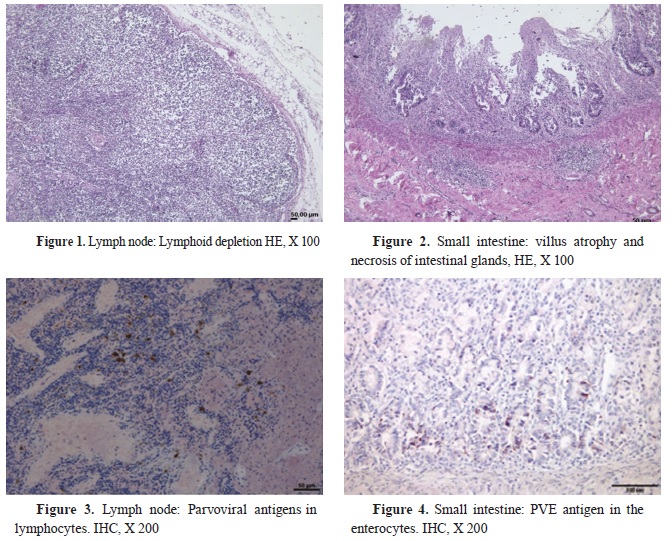4. Gombač, M., Švara, T., Tadić, M., Pogačnik, M. (2008). Retrospective study of canine parvovirosis in Slovenia. Slov Vet Res. 45(2): 73-78.
5. Patterson, E.V., Reese, M.J., Tucker, S.J., Dubovi, E.J., Crawford, P.C., Levy, J.K. (2007). Effect of vaccination on parvovirus antigen testing in kittens. J Am Vet Med Assoc. 230(3): 359-363.
https://doi.org/10.2460/javma.230.3.359 PMid:17269866
6. Pollock, R.V., Carmichael, L.E. (1982). Maternally derived immunity to canine parvovirus infection: transfer, decline, and interference with vaccination. J Am Vet Med Assoc. 180(1): 37-42.
7. Decaro, N., Elia, G., Martella, V., Campolo, M., Desario, C., Camero, M., Cirone, F., et al. (2006). Characterisation of the canine parvovirus type 2 variants using minor groove binder probe technology. J Virol Methods. 133(1): 92-99.
https://doi.org/10.1016/j.jviromet.2005.10.026 PMid:16313976
8. Kahn, C.M., Line, S., Aiello, S.E. (2005). The Merck veterinary manual. Merck & Co. Inc., Whitehouse Station, NJ.
9. Hoskins, D.J. (1998). Canine viral enteritis. In: Greene, C.E. (Ed.), Infectious diseases of the dogs and cats. 2nd ed. (pp. 40-48). Philadelphia: W.B. Saunders Co.
10. Mosallanejad, B., Ghorbanpoor, N.M., Avizeh, R.R.A. (2008). Prevalence of canine parvovirus (CPV) in diarrheic dogs referred to veterinary hospital in Ahvaz. Arch Razi Inst. 63(2): 41-46.
11. Yilmaz, Z., Pratelli, A., Torun, S. (2005). Distribution of antigen types of canine parvovirus type 2 in dogs with hemorrhagic enteritis in Turkey. Turkish J Vet Anim Sci. 29(4): 1073-1076.
12. Ettinger, S.J., Feldman, E.C. (1995). Textbook of veterinary internal medicine. 4th. Ed. Section VIII: The Respiratory System. Philadelphia: W.B. Saunders.
13. Cooper, B.J., Carmichael, L.E., Appel, M.J., Greisen, H. (1979). Canine viral enteritis. II. Morphologic lesions in naturally occurring parvovirus infection. Cornell Vet. 69(3): 134-144.
14. Hayes, M.A., Russel, R.G., Mueller, R.W., Lewis, R.J. (1979). Myocarditis in young dogs associated with a parvovirus-like agent. Can Vet J. 20(5): 126.
15.Robinson, W.F., Huxtable, C.R., Pass, D.A. (1980). Canine parvoviral myocarditis: a morphologic description of the natural disease. Vet Pathol. 17(3): 282-293.
https://doi.org/10.1177/030098588001700302 PMid:7368523
16. Bergmann, V., Baumann, G., Fuchs, H.W. (1980). Experiences in the postmortem diagnosis of parvovirus enteritis in the dogs. [Zur postmortalen Diagnostik der Parvovirus-Enteritis des Hundes]. Arch Exp Veterinarmed. 37(1): 127-133. [in German]
17. Breuer, W., Stahr, K., Majzoub, M., Hermanns, W. (1998). Bone-marrow changes in infectious diseases and lymphohaemopoietic neoplasias in dogs and cats-a retrospective study. J Comp Pathol. 119(1): 57-66.
https://doi.org/10.1016/S0021-9975(98)80071-6 PMid:9717127
18. Vural, S.A., Alcigir, G. (2011). Histopathological and immunohistological findings in canine parvoviral infection: diagnosis application. Revue Méd Vét. 162(2): 59-64.
19. Maxson, T.R., Meurs, K.M., Lehmkuhl, L.B., Magnon, A.L., Weisbrode, S.E., Atkins, C.E. (2001). Polymerase chain reaction analysis for viruses in paraffin-embedded myocardium from dogs with dilated cardiomyopathy or myocarditis. Am J Vet Res. 62(1): 130-135.
https://doi.org/10.2460/ajvr.2001.62.130 PMid:11197551
20. Mulvey, J.J., Bech-Nielsen, S., Haskins, M.E., Taylor, H.W., Eugster, A.K. (1980). Myocarditis induced by parvoviral infection in weanling pups in the United States. J Am Vet Med Assoc. 177(8): 695-698.
21. Desario, C., Decaro, N., Campolo, M., Cavalli, A., Cirone, F., Elia, G., Martella, V., et al. (2005). Canine parvovirus infection: which diagnostic test for virus? J Virol Methods. 126(1-2): 179-185.
https://doi.org/10.1016/j.jviromet.2005.02.006 PMid:15847935
22. Waldvogel, A.S., Hassam, S., Stoerckle, N., Weilenmann, R., Tratschin, J.D., Siegl, G., Pospischil, A. (1992). Specific diagnosis of parvovirus enteritis in dogs and cats by in situ hybridization. J Comp Pathol. 107(2): 141-146.
https://doi.org/10.1016/0021-9975(92)90031-O PMid:1333495
23. Gjurovski, I., Angelovski, B., Dovenski, T., Mitrov, D., Ristoski, T. (2015). Diagnostic characteristics of circovirus infection in pigs. Mac Vet Rev. 38(1): 73-78.
https://doi.org/10.14432/j.macvetrev.2014.11.033 24. Vural, S.A., Alcigir, G. (2011). Histopathological and immunohistological findings in canine parvoviral infection: diagnosis application. Revue Méd Vét. 162(2): 59-64.
25. Gjurovski, I., Dovenska, M., Kunovska, S.K., Milosevski, J., Trajkov, V.L., Ristoski, T. (2019). Mammary adenocarcinoma with widespread metastasis in a lion. Mac Vet Rev. 42(2): 195-199.
https://doi.org/10.2478/macvetrev-2019-0019 26. Azetaka, M., Hirasawa, T., Konishi, S., Ogata, M. (1981). Studies on canine parvovirus isolation, experimental infection and serologic survey. Nihon Juigaku Zasshi. 43(2): 243-255.
https://doi.org/10.1292/jvms1939.43.243 PMid:7289337
27. Danner, K., Oldenburg, U., Weber, S., Arens, M., Krauss, H. (1982). Current epizootiological situation in virus-related canine enteritis. [Derzeitige epizootiologische Situation bei virusbedingten Enteritiden des Hundes]. Praktische Tierarzt. 63, 512 - 518. [in German]
28. Jakov, N., Nenad, M., Andrea, R., Dejan, K., Dragan, M., Aleksandra, K., Marina, R., et al. (2021). Genetic analysis and distribution of porcine parvoviruses detected in the organs of wild boars in Serbia. Acta Veterinaria 71(1): 32-46.
https://doi.org/10.2478/acve-2021-0003 29. Kubašová, I., Štempelová, L., Maďari, A., Bujňáková, D., Micenková, L., Strompfová, V. (2022). Application of canine-derived DSM 32820 in dogs with acute idiopathic diarrhoea. Acta Veterinaria 72(2): 167-183.
https://doi.org/10.2478/acve-2022-0014 30. Evermann, J.F., Abbott, J.R., Han, S. (2005). Canine coronavirus-associated puppy mortality without evidence of concurrent canine parvovirus infection. J Vet Diagn. 17(6): 610-614.
https://doi.org/10.1177/104063870501700618 PMid:16475526
31. Url, A., Schmidt, P. (2005). Do canine parvoviruses affect canine neurons? An immunohistochemical study. Res Vet Sci. 79(1): 57-59.
https://doi.org/10.1016/j.rvsc.2004.11.003 PMid:15894025
32. Berkin, S., Milli, U., Urman, H.K. (1981). Canine parvoviral enteritis in Turkey. Vet J Ank Uni. 28, 36-49.

 10.2478/macvetrev-2023-0024
10.2478/macvetrev-2023-0024


